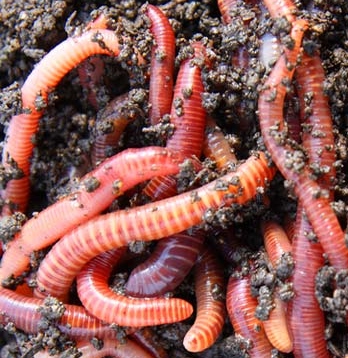Red wigglers: How to find them
Whatever You Required to Know Concerning Red Wigglers for Composting
Red wigglers, or Eisenia fetida, play an essential function in the realm of composting, changing organic waste into valuable dirt modifications. The process of establishing up a worm container and preserving it can position challenges.
What Are Red Wigglers?

(red worms)
Indigenous to North America, red wigglers are surface-dwelling organisms that choose moist, cozy habitats abundant in disintegrating raw material. Their diet is composed mainly of decomposing plant material, food scraps, and various other organic debris, which they take in and break down effectively. As they absorb this material, they produce nutrient-rich castings that boost soil fertility.
Red wigglers are hermaphroditic, possessing both male and female reproductive body organs, and can recreate quickly under ideal problems. This capacity makes them a perfect option for composting systems, as their population can boost quickly. Their durability and adaptability to various atmospheres even more strengthen their significance in lasting waste management practices. Generally, red wigglers are vital contributors to the process of recycling organic waste right into important compost.
Benefits of Utilizing Red Wigglers
Using red wigglers in composting systems supplies various advantages that enhance both the performance of waste monitoring and the top quality of the resulting compost. These worms, clinically called Eisenia fetida, are specifically efficient at breaking down raw material, transforming kitchen scraps and yard waste right into nutrient-rich compost at an accelerated price.
Among the main advantages of utilizing red wigglers is their ability to consume huge quantities of organic material, commonly refining their weight in food waste daily. This high consumption price causes faster disintegration and minimizes the quantity of waste sent to land fills. Moreover, the castings generated by red wigglers are rich in essential nutrients, valuable microorganisms, and enzymes, making them an excellent plant food for gardens and plants.
Additionally, red wigglers prosper in a selection of environments, making them versatile for both indoor and outside composting systems - red wigglers. Their presence in a compost bin aids to aerate the material, protecting against smells and advertising a healthy composting procedure. Overall, utilizing red wigglers not just adds to efficient waste management yet likewise sustains lasting gardening practices with the production of top quality compost
(Lake Rhodhiss Worms)
Setting Up Your Worm Container
To effectively establish a worm bin, it is necessary to pick a proper container that meets the demands of red wigglers while offering a favorable setting for additional hints composting. An appropriate container can be made from plastic, wood, or steel, with a capacity of at the very least 1 square foot for every pound of worms.
Guarantee the container has ample drain openings to avoid excess dampness, as red wigglers flourish in a damp, but not water logged, setting. red wigglers. The bin needs to also be aerated to give enough air movement, preventing anaerobic problems that can harm the worms
A suitable area for the worm container is a great, dark location, free from straight sunshine and severe temperatures, as red wigglers like a temperature level variety of 55 to 77 levels Fahrenheit.
Prior to introducing the worms, prepare bed linen products such as shredded paper, cardboard, or coconut coir, which will certainly supply both environment and food. Dampen the bed linens gently to create a welcoming atmosphere for the worms. Consider positioning a lid on the bin to preserve humidity and lower bugs, while guaranteeing it can be conveniently gotten rid of for upkeep.
Feeding and Care Guidelines
Feeding red wigglers is a vital element of preserving a healthy and balanced composting system. These worms prosper on a diverse diet plan, mostly composed of organic materials such as fruit and vegetable scraps, coffee grounds, and smashed eggshells. It is important to prevent feeding them meat, dairy, and oily foods, as these can create unpleasant smells and bring in bugs.
When presenting food to your worm bin, cut or shred products right into smaller pieces to facilitate quicker disintegration. Beginning with percentages to determine the worms' usage rate, gradually raising the amount as they adapt. It is a good idea to alternate feeding areas within the container to encourage thorough blending and oygenation of the garden compost.

Troubleshooting Common Issues
Maintaining a flourishing worm composting system can in some cases present challenges that require attention and troubleshooting. Usual issues include an unpleasant odor, which often indicates overfeeding or the visibility of anaerobic problems. To correct this, decrease the quantity of food added and guarantee appropriate aeration by mixing the bed linen material.
Another constant problem is the retreat of worms from the container. This can occur due to too much wetness or unsuitable ecological problems. Routinely check the dampness degrees, aiming for a wet however not soggy consistency, and preserve optimum temperature levels between 60-80 ° F(15-27 ° C )to develop a comfortable environment for your red wigglers.
Insects, such as fruit flies, can also invade worm containers. red wigglers. To combat this, cover food scraps with a layer of bed linens or shredded paper to hinder flies from laying eggs. In addition, guarantee that any food added is fresh and devoid of mold, which can bring in unwanted bugs
Finally, if your worms seem inactive, look for anxiety factors such as temperature level fluctuations or insufficient dampness. Addressing these usual issues will certainly aid maintain a healthy and balanced and productive worm composting system.
Final Thought
In recap, red wigglers, or Eisenia fetida, play an important role in lasting waste management through vermicomposting. Their ability to effectively transform organic waste right into nutrient-dense spreadings boosts soil health and wellness and advertises plant development. Proper configuration and upkeep of a worm container, together with adherence to feeding standards, guarantee a successful ecosystem that reduces garbage dump payments. Resolving common concerns promptly further supports the efficiency of this environmental method, adding to ecological sustainability and farming productivity.